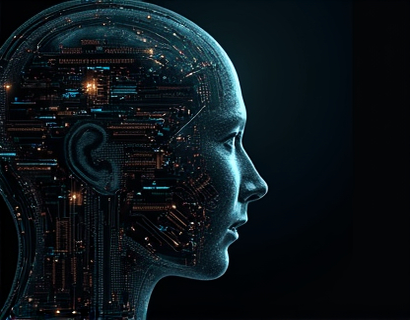Decentralized Web3 Identity: A Beginner's Guide to Secure and Intuitive Digital Presence in the Evolving Online Landscape
The advent of Web3 has ushered in a new era of digital identity, promising a more secure, private, and user-controlled online presence. For Web3 enthusiasts and digital identity seekers, understanding the concept of decentralized Web3 identity is crucial. This guide aims to demystify the complexities surrounding Web3 handles and domains, providing essential insights and practical tools to establish a secure and user-friendly online presence.
Decentralized Web3 identity is fundamentally different from the centralized identity models we have been accustomed to. In the traditional internet, identity is managed by central authorities such as governments and corporations, which store and control our personal data. This centralization poses significant risks, including data breaches, identity theft, and loss of control over personal information. Web3 identity, on the other hand, leverages blockchain technology to give individuals full ownership and control over their digital identities.
Understanding Decentralized Identity
At its core, decentralized identity is about empowering users to manage their own data without relying on intermediaries. This is achieved through blockchain-based solutions that create a secure and transparent system for identity verification and management. The key components of decentralized Web3 identity include self-sovereign identity (SSI), decentralized identifiers (DIDs), and verifiable credentials.
Self-sovereign identity is a concept where individuals have complete control over their personal data and identity attributes. This means that users can choose what information to share, with whom, and under what conditions. DIDs are unique identifiers that replace traditional usernames and passwords, providing a secure and decentralized way to represent identity on the web. Verifiable credentials are digital certificates that confirm specific attributes or achievements, such as education degrees or professional certifications, and can be stored and shared securely.
Benefits of Decentralized Web3 Identity
The shift to decentralized Web3 identity offers numerous advantages over traditional centralized systems. First and foremost, it enhances security by eliminating single points of failure and reducing the risk of large-scale data breaches. Since users control their own data, the likelihood of sensitive information being compromised is significantly lower.
Privacy is another major benefit. With decentralized identity, users can selectively share only the necessary information for a specific interaction, without revealing more than required. This granular control over personal data helps maintain privacy and reduces the risk of unauthorized data usage. Additionally, decentralized identity systems are more resilient to censorship and manipulation, as there is no central authority that can arbitrarily block or alter identity information.
Convenience is also a significant advantage. Decentralized identity solutions streamline the process of managing multiple online accounts and credentials. Users can store all their identity attributes in a single, secure wallet, eliminating the need to remember multiple usernames and passwords. This not only simplifies the user experience but also reduces the friction associated with online interactions.
Key Technologies Behind Decentralized Web3 Identity
Several key technologies drive the functionality and security of decentralized Web3 identity systems. Blockchain technology serves as the foundation, providing a decentralized and immutable ledger for storing and verifying identity data. Smart contracts, self-executing contracts with the terms directly written into code, play a crucial role in automating and enforcing identity-related processes.
Decentralized identifiers (DIDs) are unique, user-controlled identifiers that replace traditional usernames and passwords. DIDs are tied to cryptographic keys, ensuring that only the rightful owner can access and manage their identity data. Verifiable credentials, built on top of DIDs, allow users to prove specific attributes or achievements to third parties in a secure and auditable manner.
Another important technology is Web3 wallets, which serve as digital vaults for storing and managing Web3 assets, including identity credentials. These wallets can be software-based, running on a user's device, or hardware-based, providing an additional layer of security. Web3 browsers and applications also facilitate seamless interactions with decentralized identity systems, making it easier for users to navigate and manage their online presence.
Creating a Decentralized Web3 Identity
For those looking to establish a decentralized Web3 identity, the process involves several steps. First, users need to set up a Web3 wallet, which can be done using various platforms and devices. Popular options include MetaMask for the Ethereum ecosystem and WalletConnect for cross-chain compatibility. Once a wallet is set up, users can generate their DID, which serves as the root identifier for their decentralized identity.
After creating a DID, users can issue verifiable credentials from trusted issuers. These issuers can be educational institutions, employers, or any other entity that can validate and certify specific attributes. The credentials are stored in the user's wallet and can be shared selectively with service providers or other parties that require verification.
To interact with decentralized services, users need to provide their DID and any relevant credentials. Web3 applications and services are designed to request and verify these credentials using smart contracts, ensuring a secure and automated process. This eliminates the need for manual verification and reduces the risk of fraud.
Challenges and Considerations
While decentralized Web3 identity offers many benefits, there are also challenges and considerations to keep in mind. One of the primary challenges is user education. Many individuals are still unfamiliar with blockchain technology and decentralized systems, which can hinder adoption. Simplifying the user experience and providing intuitive tools is essential to overcome this barrier.
Interoperability is another critical aspect. As the Web3 ecosystem grows, ensuring that different platforms and services can seamlessly interact with each other is vital. Standardization efforts, such as those led by the W3C Decentralized Identifiers (DID) Working Group, aim to create common protocols and formats that facilitate interoperability.
Regulatory compliance is also a consideration, as the legal landscape for digital identities is still evolving. Users should stay informed about the regulations in their jurisdiction and ensure that their Web3 identity solutions comply with relevant laws and standards.
Future of Decentralized Web3 Identity
The future of decentralized Web3 identity looks promising, with ongoing developments aimed at enhancing functionality and user adoption. One area of focus is improving the user experience through more intuitive interfaces and simplified workflows. This includes the development of user-friendly wallets and applications that require minimal technical knowledge to use.
Scalability is another key area of improvement. As the number of users and transactions grows, decentralized identity systems must scale efficiently without compromising performance or security. Layer 2 solutions and off-chain storage are among the techniques being explored to address scalability challenges.
Integration with existing systems is also on the horizon. As more organizations adopt Web3 technologies, the need for seamless integration with traditional systems will increase. This will enable a smoother transition for users and businesses, making decentralized identity a more viable option for a broader audience.
Conclusion
Decentralized Web3 identity represents a significant shift in how we manage and protect our online presence. By giving individuals full control over their personal data and identity attributes, Web3 identity enhances security, privacy, and convenience. While there are challenges to overcome, the potential benefits make it a compelling choice for Web3 enthusiasts and digital identity seekers.
As the technology continues to evolve, we can expect to see more user-friendly tools and broader adoption across various industries. For those ready to take the first step, the resources and tools mentioned in this guide provide a solid foundation for establishing a secure and intuitive Web3 identity.










































